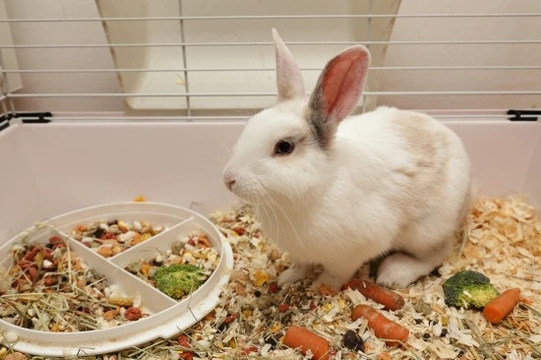Pets
Pets for studWanted petsBreedersAccessories & services
Knowledge hub
Support
Support & safety portal
Different ways of keeping a house rabbit
While the concept of keeping rabbits as an indoor pet rather than in a hutch and run in the garden is a fairly recent idea, keeping rabbits as in-house pets is becoming increasingly more popular each year. Keeping your bunny inside has a range of benefits, including keeping them safe from predators, allowing more contact with your rabbit and forging a closer bond, and protecting them from the worst extremes of the weather. When your rabbit lives indoors with you, they really become part of the family, and give you the chance to see a whole new element of rabbit life.
If you are thinking of keeping a house rabbit, there are a range of different ways of accommodating them and providing them with a suitable, safe enclosure. In this article, we will look at the different options that are available to you when it comes to housing your indoor-kept rabbit.
A puppy pen
Using a puppy pen is one of the best ways to provide accommodation for your indoor rabbit, plus it has the added benefit of being totally portable if you need to move it. A puppy pen consists of a stiff wire fence with several sides, that can be put together to provide a roofless cage within any given room. It is important to pick a puppy pen that is high enough that your rabbit cannot simply jump out of, with three feet high being the recommended minimum.
If you have carpeted floors, you can put paper, a rug or linoleum down inside of the pen to stop your rabbit damaging your carpet too.
A puppy pen is useful both inside of the house, and for putting in the garden for your rabbit when they go outside. It also means that you can let your rabbit out easily for a supervised roam around the house, and the roofless structure makes it easy to lift your rabbit in and out.
A rabbit apartment
There are loads of easy ways to build an impressive bunny apartment complex for your rabbit, from simple stacked storage cubes to mesh cages to purpose-build wood and mesh constructions. You can order apartments like this online, or even consider building your own! If you do intend to build your own rabbit apartment, take care not to use chicken wire within it, as this is too thin for rabbits and may be chewed through or damage their paws.
How much you ultimately spend on your rabbit apartment is up to you, and they do not have to be expensive to construct. Once you have set up your rabbit apartment, you can even potentially add extra rooms to it as you go along. Ensure that it is large enough to provide plenty of space for your rabbit to move around and play in, and dedicate a room to a comfortable sleeping area, as well as a section for your rabbit’s litter tray to make for easier clean ups.
A hutch or cage
Using a simple hutch or cage for your rabbit is often the least expensive and easiest to source option, but they do tend to be less spacious than other options. If your rabbit does live within a cage, even a large one, it is extra important to ensure that your rabbit has plenty of time spent outside of the cage each day too, and is not left cooped up for long periods of time.
When choosing a cage for your rabbit, the larger the cage the better, as you will need to ensure that there is plenty of room for your rabbit’s bedding, food, toys, and litter tray, as well as space to stretch their legs.
Pick a cage that is easy for your rabbit to get in and out of when they are permitted to, and again, steer clear of anything constructed from chicken wire.
Free range to roam in a secured room
You can of course allow your rabbit to have the freedom to move around at their leisure in a suitable room dedicated to your bunny, which must be rabbit-proofed before they enter it! The room must have a secure door and no gaps or vents that your rabbit could use to escape through, and no trailing wires or other potential hazards hanging around that your bunny could get their teeth into!
You should dedicate a corner of the room to being a rabbit station, containing their bed and food and water, and place the litter box in another location. When your rabbit has free range of an entire room, you will also have lots of options in terms of adding fun furniture, toys and games to keep your rabbit occupied as well.
Ensure that the room is not too exposed, and has plenty of hidey holes that your rabbit can use for shelter. In order to address the issue of not knowing where your rabbit is before you open the room door to enter it, you might wish to consider either a stable door system, or a door with a glass viewing panel in it.



